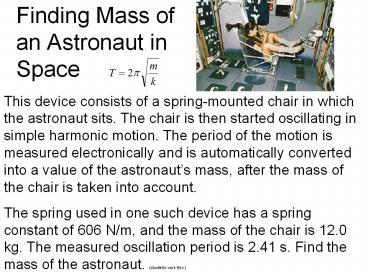Finding Mass of an Astronaut in Space PowerPoint PPT Presentation
1 / 22
Title: Finding Mass of an Astronaut in Space
1
Finding Mass of an Astronaut in Space
This device consists of a spring-mounted chair in
which the astronaut sits. The chair is then
started oscillating in simple harmonic motion.
The period of the motion is measured
electronically and is automatically converted
into a value of the astronauts mass, after the
mass of the chair is taken into account. The
spring used in one such device has a spring
constant of 606 N/m, and the mass of the chair is
12.0 kg. The measured oscillation period is 2.41
s. Find the mass of the astronaut. (students work
this.)
2
Mass of an Astronaut
3
Example 1 The Wavelengths of Radio Waves AM and
FM radio waves are transverse waves consisting of
electric and magnetic field disturbances
traveling at a speed of 3.00x108m/s. (What is
this number?) A station broadcasts AM radio waves
whose frequency is 1230x103Hz and an FM radio
wave whose frequency is 91.9x106Hz. Find the
distance between adjacent crests in each wave.
4
16.2 Periodic Waves
Example 1 The Wavelengths of Radio Waves AM and
FM radio waves are transverse waves consisting of
electric and magnetic field disturbances
traveling at a speed of 3.00x108m/s. A
station broadcasts AM radio waves whose frequency
is 1230x103Hz and an FM radio wave whose
frequency is 91.9x106Hz. Find the distance
between adjacent crests in each wave.
5
16.2 Periodic Waves
AM
FM
6
Problem
- Light travels at 3 10 8 m/s. Sound travels at
331 m/s. - If lightning strikes 8.2km away from you, how
long passes before you see it? - How long passes until you hear it?
- (students work this.)
7
Problem
- Light travels at 3 10 8 m/s. Sound travels at
331 m/s. - V d/t gt t d/v
- If lightning strikes 8.2km away from you, how
long passes before you see it? - t d/v 8200m / 3 10 8 m/s
- How long passes until you hear it?
- t d/v 8200m / 331 m/s
- (students work this.)
8
Problem
- So you see lightning hit 1 mile away, how many
seconds do you count before you hear it? - (students work this.)
9
Problem
- So you see lightning hit 1 mile away, how many
seconds do you count before you hear it? - t d/v 1609m / 331 m/s
- So each 5 sec is about 1 mile away.
- Each 1 sec is about 3 football fields away.
- (Talk about military timing of artillery and
nukes.)
10
THE PRINCIPLE OF LINEAR SUPERPOSITION When two
or more waves are present simultaneously at the
same place, the resultant disturbance is the sum
of the disturbances from the individual waves.
11
Constructive Interference
- Two waves, a and b, have the same frequency and
amplitude - Are in phase
- The combined wave, c, has the same frequency and
a greater amplitude
12
Destructive Interference
- Two waves, a and b, have the same amplitude and
frequency - They are half a cycle out of phase
- When they combine, the waveforms cancel
13
Reflection of Waves Fixed End
- Whenever a traveling wave reaches a boundary,
some or all of the wave is reflected
14
Reflection of Waves Fixed End
- Whenever a traveling wave reaches a boundary,
some or all of the wave is reflected - When it is reflected from a fixed end, the wave
is inverted - The shape remains the same
15
What happens when a wave interferes with its own
reflection?
- Sometimes we get standing waves.
16
(No Transcript)
17
(No Transcript)
18
1st Harmonic
19
2nd Harmonic
20
3rd Harmonic
21
(No Transcript)
22
- The a string will only allow certain wavelengths
to be standing waves. - Because the endpoints need to be nodes.
- For a string with two fixed ends,
- ? 2L / n n 1, 2, 3, 4 .

